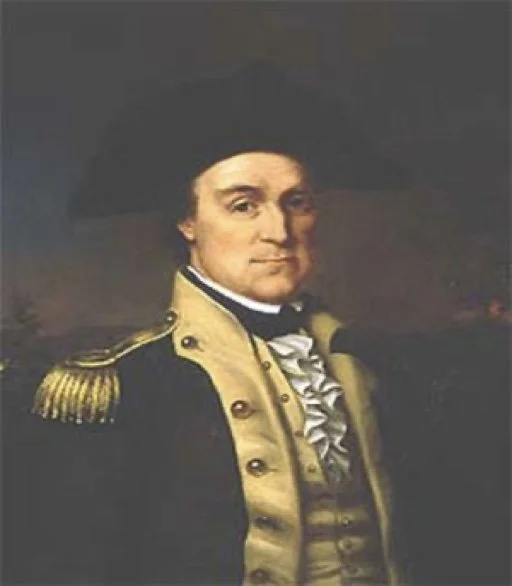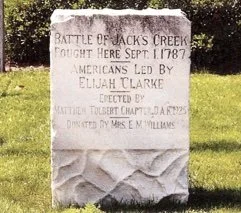GENERAL ELIJAH CLARKE
(1742-1799)
General Elijah Clarke, a Revolutionary War hero and the most famous frontiersman of this region, led a small group of settlers against Creek forces at nearby Jack’s Creek on September 21, 1787. He was born in 1742 in South Carolina and arrived in the northwest Georgia frontier in 1773.
Elijah Clarke served as captain and lieutenant colonel in several Revolutionary War battles, including the Battle of Kettle Creek in 1779. He led militias against Cherokee and Creek forces across Georgia and became the “most popular of the backwoods Indian fighters.” In the mid-1780s, clashes between Creek forces and frontier families worsened. On April 13, 1787, then Brigadier General Clarke wrote Governor George Mathews about houses burned and horses stolen by the Creeks near High Shoals and asked for ammunition and supplies to help defend the settlers. The historic Battle of Jack’s Creek occurred a few months later just east of present-day Monroe. Most of the frontiersmen who fought under Clarke’s command were Revolutionary War veterans like Clarke. He was accompanied by his 21-year-old son John who would later serve two terms as Georgia governor. According to Elijah Clarke’s written account of the battle dated Long Cane, September 24, 1787:
“I had certain information that a man was killed on the 17th near Greensborough by a party of six or seven Indians and that Colonel Barber was waylaid by fifty or sixty Indians and wounded and three of his party killed. This determined me to raise what men I could in the course of twenty-four hours and march with them to protect the frontiers. I collected 160 men, chiefly volunteers, and proceeded to the place where Colonel Barber had been attacked. There I found the bodies of the three men mentioned above mangled in a shocking manner and after I had buried them proceeded on the trail of the murderers as far as the south fork of the Ocmulgee, where finding that I had no chance of overtaking them I left and went up said River till I met with a fresh trail of Indians coming toward our frontier settlements. I immediately turned and followed the trail until the morning of the 21st between eleven and twelve o’clock when I came up with them. They had just crossed a branch called Jack’s Creek through a thick cane-brake and were encamped and cooking upon an eminence. My force consisted of 130 men, 30 having been sent back on account of horses being tired and lost. I drew up my men in three divisions: the right commanded by Colonel (Holman) Freeman, the left by Major (John) Clark, and the middle by myself. Colonel Freeman and Major Clark were ordered to surround and charge the Indians, which they did with such dexterity and spirit that they immediately drove them from the encampment back into the cane-brake, where finding it impossible for them to escape they obstinately returned our fire until half past four o’clock when they ceased except now and then a shot. From every circumstance I am certain that there was not less than twenty-five Indians killed and am induced to suppose that had I remained that night I should have found forty or fifty dead of their wounds by the morning.”
After the war, Clarke served in the state assembly and constitutional convention of 1789, but became dissatisfied with failures of the state and national government to settle conflicts on the frontier. In 1794 he organized the independent Trans-Oconee Republic by seizing traditional Creek lands. He died in Augusta in 1799, having lost everything except his plantation home. The Georgia legislature named Clarke County in his honor in December 1801.


